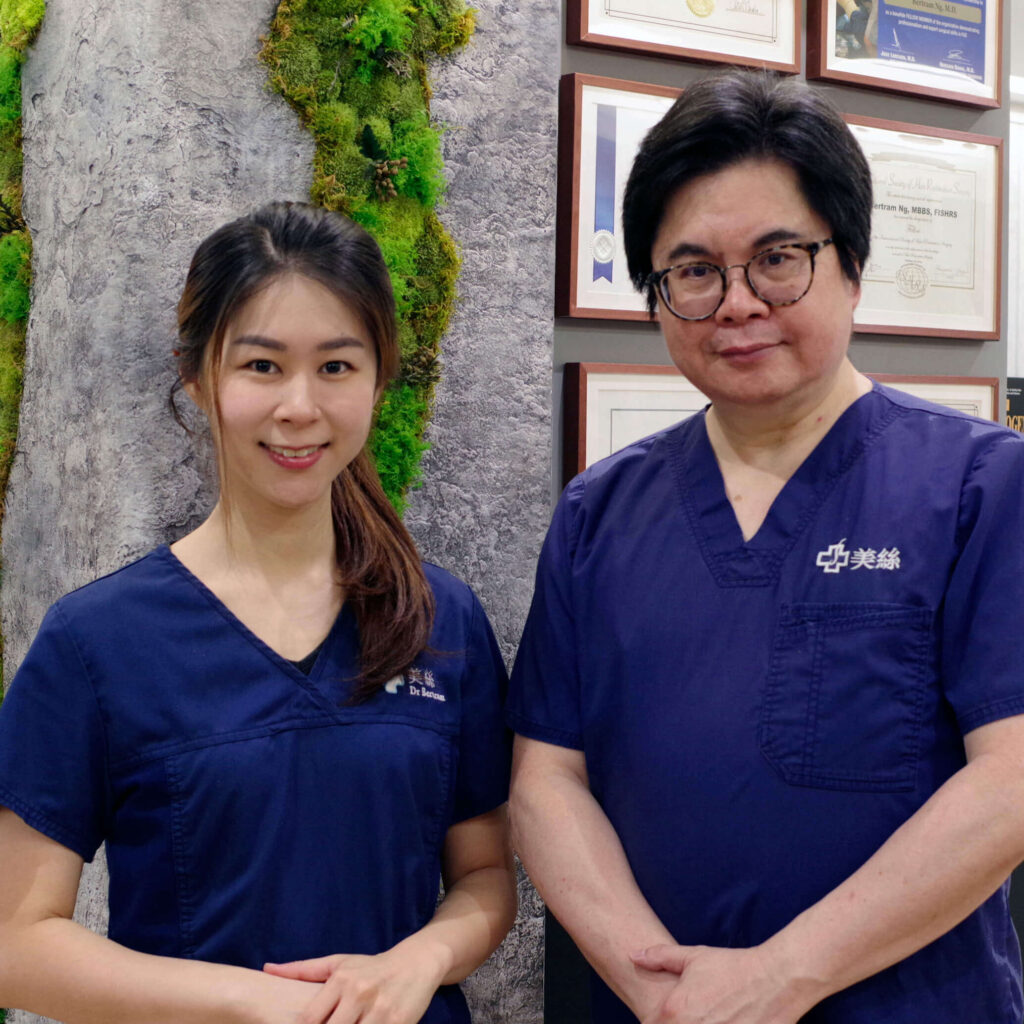- Hotline: 852+ 2891 9689
- Whatsapp: 852+ 9146 8426
- [email protected]
- 6/F 29 Austin Road, Tsimshatsui, Kowloon, Hong Kong
Unlike men, who often experience receding hairlines or bald patches, many women suffer from diffuse patterned alopecia (DPA) that’s often more difficult to detect, diagnose, and treat early. The progressive thinning is along the parting line from the frontal scalp through to the crown.
Genetic Factors (Female Pattern Hair Loss – FPHL)
• The most common cause.
• Gradual thinning across the top and crown while preserving the frontal hairline.
• Often begins after puberty and worsens after menopause.
Hormonal Imbalance
• Pregnancy, menopause, polycystic ovarian syndrome (PCOS), or thyroid disorders.
• Shifts in estrogen and androgen levels disrupt the hair cycle.
Stress and Illness
• Major emotional or physical stress (e.g., surgery, trauma, infection).
• Leads to telogen effluvium, where hair prematurely enters the shedding phase.
Nutritional Deficiencies
• Iron, zinc, vitamin D, or protein deficiencies can weaken hair roots.
• Common in women with restrictive diets or gastrointestinal absorption issues.
Medications
• Some antidepressants, blood pressure drugs, contraceptives, and chemotherapy.
• May trigger temporary or long-term shedding.
Autoimmune Conditions
• Disorders like alopecia areata, lupus, or lichen planopilaris can cause patchy or diffuse loss.
• Often associated with inflammation and scarring.
Hairstyling Practices (Traction Alopecia)
• Tight ponytails, braiding, extensions, and frequent chemical treatments can damage follicles over time.
Styling Becomes Difficult
Thinner hair exposes more scalp, making parting and volume control frustrating.
Psychological Distress
Hair is deeply tied to self-image. Women with hair loss often report anxiety, low self-esteem, and social withdrawal.
Delayed Diagnosis
Because diffuse loss is subtle and progresses gradually, it’s often ignored until it becomes advanced — making treatment harder.
Not all women with diffuse hair loss need a transplant. But all need proper medical evaluation. Treatment options may include:
Oral or topical medications
Nutritional support
Low-level laser therapy (LLLT)
Scalp PRP
Carefully planned hair transplant for localized areas
Even in eligible candidates, medical treatment (e.g., minoxidil, PRP, LLLT) is often started before surgery to stabilize hair loss and improve donor quality.
Not all women with diffuse hair loss need a transplant. A proper medical evaluation is crucial to select the most suitable treatment options which include:
Here’s a breakdown of which categories from the list above are suitable for hair transplant — and which typically are not:
Stable Female Pattern Hair Loss (FPHL)
• Thinning confined to the central scalp or parting line
• Hair loss has stabilized (no rapid progression)
• Good donor density at the back of the scalp
✅ These women often benefit from transplant to increase density at the crown or top.
Frontal Hairline or Apex Thinning
• Frontal zone or “corners” show visible scalp
• Desire to reshape or soften a high hairline
• Transplant can be used to lower hairline or frame the face
✅ Especially effective when combined with the Female Hairline Extension Technique.
Traction Alopecia or Localized Damage
• Caused by long-term hairstyling stress (tight ponytails, extensions)
• Localized and non-scarring
✅ Hair transplant can permanently restore lost density in the affected zones.
Post-Menopausal Patients with Stable Hair Loss
• Hormonal fluctuation has settled
• Hair loss is no longer spreading
✅ More predictable transplant outcomes in this group.
Diffuse Unpatterned Alopecia (DUPA)
• Thinning occurs even in the donor area
• Patients with >50% miniaturization in recipient zones
• High risk of shock loss and poor graft survival.
• Generalized thinning across the entire scalp, known as diffuse unpatterned alopecia (DUPA)
🚫 Unsafe to harvest — transplanted hair may also thin over time.
Active Autoimmune or Scarring Conditions
• Lichen planopilaris, frontal fibrosing alopecia, lupus, etc.
🚫 Ongoing inflammation can damage grafts post-transplant.
Severe Telogen Effluvium
• Temporary hair shedding due to stress or illness
🚫 Hair usually regrows with time or medical treatment.
Poor Donor Density
• Very fine or sparse hair at the back of the scalp
🚫 May not yield enough grafts for meaningful improvement.
Unrealistic expectations or perfectionist mindset
e.g. “I don’t want to see my scalp ever again”
Body Dysmorphic Disorder, obsessive perfectionism
Our ethical practice emphasizes patient safety and satisfaction over sales. That’s why we screen every patient carefully before offering surgery.
Even in eligible candidates, medical treatment (e.g., minoxidil, PRP, LLLT) is often started before surgery to stabilize hair loss and improve donor quality.
Restoring density along the midline can yield excellent cosmetic improvement and restore styling flexibility. A properly executed transplant can soften the visible part, reduce scalp show, and frame the face more effectively—boosting both confidence and femininity.
However, success depends not only on technique, but also on expectation. This is where our doctor-led consultation becomes essential.
Hair transplant adds density—not thickness. It cannot reverse hair caliber, nor restore the fullness seen in childhood. It is important to understand that even women with no hair loss often see their scalp when hair is parted or under bright lighting.
Our goal is to make your hair look fuller and style better, not to create an illusion of perfectly thick hair. Patients must weigh the visual gain against the cost, downtime, and recovery.
If that trade-off feels worthwhile, you’re likely a strong candidate.
Women who experience progressive thinning along the parting line—from the frontal scalp through to the crown—may be suitable candidates for hair transplant. This pattern, known as diffuse patterned alopecia (DPA), typically preserves the donor zone and is most common in post-menopausal women, though it can occur earlier.
Because women generally have finer hair, a more fragile donor supply, and a higher risk of shock loss, we adopt a conservative approach to grafting.
In most cases, we transplant 1,800 to 2,400 grafts ( 3,200 to 4,000 Hairs ) in the first session—carefully distributed for maximum cosmetic benefit.
Most patients achieve excellent results in a single session. A touch-up procedure may be offered 12–18 months later to increase density or expand the treated zone.
The Focused Areas of Transplantation are:
✅ The central parting line – Reduces scalp show and improves part-line density
✅ The mid-scalp and crown – Optional, depending on severity and donor availability
To reduce risk, we do not over-harvest or attempt overly aggressive coverage.
We offer both FUT and FUE methods depending on your hair characteristics, scarring concerns, and styling preferences:
Transplanted hairs are permanent and do not require long-term medication to maintain results. However, if female pattern hair loss (FPHL) exists elsewhere on the scalp, we may recommend:
What sets us apart is our commitment to doctor-led, science-based planning:
Every case is personally evaluated by Dr. Bertram
Graft distribution is optimized for maximum impact with minimum trauma
We use ultra-refined tools for better survival and minimal scarring
We monitor donor health and miniaturization closely with Trichoscopy and magnified assessment
Patients receive full post-op care, including LLLT sessions and guided recovery support
Shock loss is a response to the trauma or stress of surgery. It affects not only the transplanted follicles but also the surrounding native hairs, especially those already weakened by:
Genetic thinning (miniaturization)
Hormonal imbalance
Nutritional deficiencies or underlying scalp inflammation
Recipient Area: Existing weak hairs near the grafts may fall out temporarily
Donor Area: Rare, but can occur if donor hairs are thin or if extraction is aggressive
Begins: Around 2–4 weeks post-surgery
Recovery: New growth usually starts by 3–4 months, with full recovery by 6–12 months
Most hairs regrow stronger than before, especially when supported by proper care
While it cannot always be avoided, we minimize shock loss by:
Using gentle implantation techniques
Avoiding overcrowding grafts
Pre- and post-operative use of nutritional support or low-level laser therapy (LLLT)
Sometimes pre-treating FPHL with minoxidil before surgery
In the vast majority of cases, no — the loss is temporary.
However, if the surrounding hairs were already severely miniaturized (i.e., close to falling out), they may not return.

Shock loss is common after hair transplant in female. It affects not only the transplanted follicles but also the surrounding native hairs. Candidates must be warned of this beforehand.

From consultation, surgery, to aftercare, you will receive continued personal care by our doctors, not just consultants.
Have a question? Please feel free to call our friendly customer service.
International Accreditations
Recognized by leading global medical bodies, our clinic stands as one of the most qualified and internationally accredited hair transplant centers in Hong Kong and mainland China. We are proud to uphold the highest standards in medical ethics, safety, and surgical expertise.
Hair transplant is the ultimate solution to restores hair, but not everyone is good candidate.
Our online assessment helps determine if these procedures suit you, saving you time and costs.